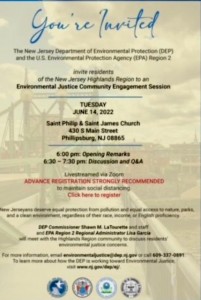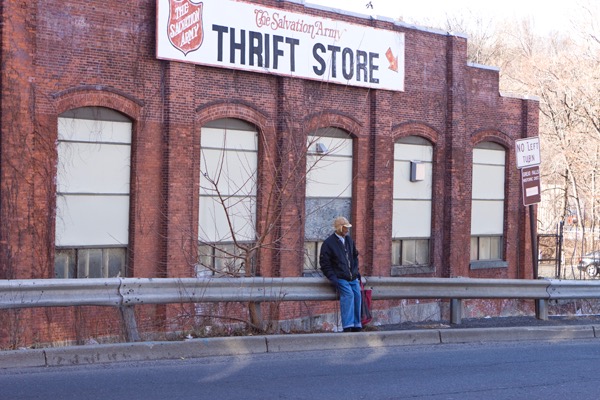Law Is Riddled With Loopholes, Exemptions, Waivers, & Vague Unenforceable Platitudes
DEP Proposed Rules Do Nothing To Enforce Vague Law Or Claw Back Compromises
Murphy and DEP Sycophants Cheer
The gaping hole between the reality of what we have become, and the fiction of who we are supposed to be, is why spectacle is all the ruling class has left. Spectacle takes the place of politics. It is a tacit admission that all social programs, whether the Build Back Better Plan, a ban on assault weapons, raising the minimum wage, ameliorating the ravages of inflation or instituting environmental reforms to stave off the climate emergency, will never be implemented. ~~~ “Society of Spectacle” – Chris Hedges
This is Part One in a series.
On Monday June 6, 2022, DEP proposed the long delayed regulations to implement the seriously flawed environmental justice law, enacted almost 2 years ago. (hit this link to read the DEP proposal. The public comment period closes on September 4, 2022).
Since the Murphy Administration began almost 6 years ago, DEP has issued thousands of air pollution and land use permits and other regulatory approvals that have increased current pollution (and greenhouse gas emissions) that impact overburdened “environmental justice communities”. This includes hundreds of permits issue AFTER the EJ bill was signed into law by Gov. Murphy on September 18, 2020 and BEFORE DEP will adopt the proposed rules (best case in mid to late 2023).
Ironically, the huge effects of the timing (delay) of DEP rules and how they apply recently was highlighted by the business community ‘s letter to Gov. Murphy in their attack on DEP’s proposed “emergency flood rules”, which would become effective and enforceable upon proposal in the NJ Register (instead of typically as much as a year later, following public hearings and public comment and DEP responses to public comments).
I have written several times to document various flaws, loopholes, exemptions, narrow application, vague standards, and scientific and technical defects of the EJ legislation, (for examples, see this and this and this).
Before the text of the proposed DEP rules was even publicly available, the Murphy DEP had launched a PR campaign and was unprofessionally spinning, the NJ lapdog media was transcribing DEP’s spin, and faux “environmental justice activists” were praising the rules, before they even read them.
And of course, I was calling out their bullshit, see also:
Just days later, right on time – literally on virtually the same day the proposed rules became available to the public – the so called “environmental justice community” issued a deeply dishonest press release that lavished praise on Gov. Murphy and DEP Commissioner LaTourette, while congratulating themselves for years of playing the inside game and providing political cover to DEP and Democratic legislators, see:
Try to read that vacuous content free press release and its gushing praise and self congratulation without vomiting.
In contrast, in reviewing the proposed rules, here are the kind of questions honest people, the media, and “environmental justice activists” should be asking, to probe the reality of whether Governor Murphy and DEP Commissioner LaTourette are walking the talk on environmental justice (the fact that DEP supported and the Gov. signed a knowingly flawed compromised EJ bill sets the stage and justifies skepticism):
- Did DEP honestly, fully and accurately describe the legislation and note specific examples where loopholes exist or compromises were made?
- Did DEP try to claw back the political losses, compromises, or flaws in the legislation via strong, specific and enforceable regulatory standards and methods?
- Did DEP seek to exercise discretion and propose strong standards in provisions of the law that were vague or delegated DEP discretion to exercise?
- Did DEP substantively modify the scientific, technical and regulatory bases for issuing current permits that ignore the EJ law? Were the standards in the EJ law incorporated into the regulations that implement all other DEP permit programs? Or will DEP continue the status quo neglect but merely use the EJ permit review process as cover and continue to manipulate EJ communities?
Some of the specific provisions of the EJ law that warrant close scrutiny of how DEP proposed to implement them with clear scientific and enforceable regulatory standards and transparent technical methods include:
- compelling public interest
- cumulative impact – cumulative cancer risks
- cause or contribute – criteria, standards, and ambient background conditions
- stressors and health endpoints
- community vulnerability and current baselines
- regional background comparison
- disproportionate impacts
- basis for permit denial
- air pollution modeling, risk assessment and risk screening methodologies
- local power to influence DEP permit decisions (the local veto in introduced version was deleted)
[Example: Have you ever even heard of DEP Technical Manual 1003 – Guidance on Preparing a Risk Assessment for Air Contaminant Emissions?
Hint: DEP recently stated that the “conservative assumptions” on page 25 of Appendix C are fully protective of public health. Remarkably, DEP bolstered that claim by noting that those critically important risk assumptions had received no public comment, thereby virtually inviting consultants for corporate polluters to challenge them (see page 2). Yet those DEP assumptions are extremely flawed: they fail to consider background pollution levels, the impacts of multiple sources of pollution, the risks of cumulative impacts, they ignore the entire concept of disproportionate burdens, or any other environmental justice considerations.]
A healthy dose of skepticism and close scrutiny of these DEP decisions is particularly necessary because the EJ law is riddled with loopholes. For example, the media has not reported that the law does not apply to many sources of pollution that cause the current levels of pollution that are creating disproportionate and unjust impacts, including:
1) all hazardous waste sites and cleanup plans, like Diamond Alkali in Newark;
2) hazardous chemical storage & manufacturing facilities, like the chemical storage plant involved in the recent nearly catastrophic Passaic City fire
3) Industries that manufacture, use or store ‘extraordinarily hazardous chemicals” (which are regulated by DEP under NJ’s Toxic Catastrophe Prevention Act, like those that caused thousands of Bhopal deaths;
4) construction or widening of roads
5) mobile source of air pollution – trucks, buses, cars, airplanes, ships, trains, etc
6) operations and pollution emissions from airports, ports, railroads, warehouses, truck depots, etc
7) “small sources” of industrial air pollution, including toxic air polluters
[Note on “small” sources: the regulatory thresholds in the bill are HUGE: for air pollution emissions its 100 tons per year; for sewage plants its 50 million gallons per day; and for industrial recycling its 100 tons per day. These thresholds result in very few facilities actually being regulated, compared to the entire universe of pollution sources.]
8) Industrial hazardous waste management facilities regulated by DEP under a federal law known as RCRA, or the toxic pollution from hundreds of toxic cleanups at these old industrial sites
9) gas and oil pipelines
10) natural gas compressor stations
10) gas stations
11) underground oil & gas storage “caverns”
12) and the grandmother loophole of them all: EMISSIONS OF GREENHOUSE GASES OR THE IMPACTS OR RISKS FROM CLIMATE CHANGE (like the “urban heat island effect” and the lack of an adequate urban parks and forestry program).
But, we get absolutely none of that healthy skepticism and honest assessment from the so called “environmental justice community”.
I’m sorry I spent so much time lambasting the liars who masquerade as “environmental justice activists”.
While, based on years of experience with the people and organizations involved, I knew this sellout was coming, I still am literally sickened by this.
I find it morally offensive to lie to poor black people and tell them that that this DEP rule proposal will protect their health or the health of their kids from current levels of pollution, or even reduce projected future pollution.
 I find it a disgrace to just trust DEP or fail to even mention the fact that DEP is an institution with a decades long failure to protect poor and black communities and years of lies and manipulation of those same communities. Why should people just trust DEP, given this history?
I find it a disgrace to just trust DEP or fail to even mention the fact that DEP is an institution with a decades long failure to protect poor and black communities and years of lies and manipulation of those same communities. Why should people just trust DEP, given this history?
Or trust the spin by former corporate lawyer DEP Commissioner LaTourette. Ah, but don’t worry about all that: he’s the first openly gay DEP Commissioner!
And to praise politicians and corporate hacks like DEP Commissioner LaTourette while doing so adds insult to injury.
We want it nailed down – with numbers and methods that are enforceable – not subject to DEP discretion.
I’ll have to get to a substantive review of the DEP proposed rule in my next post.


Pingback: WolfeNotes.com » Cultural Politics Has Hijacked The NJ Climate And Environmental Agenda